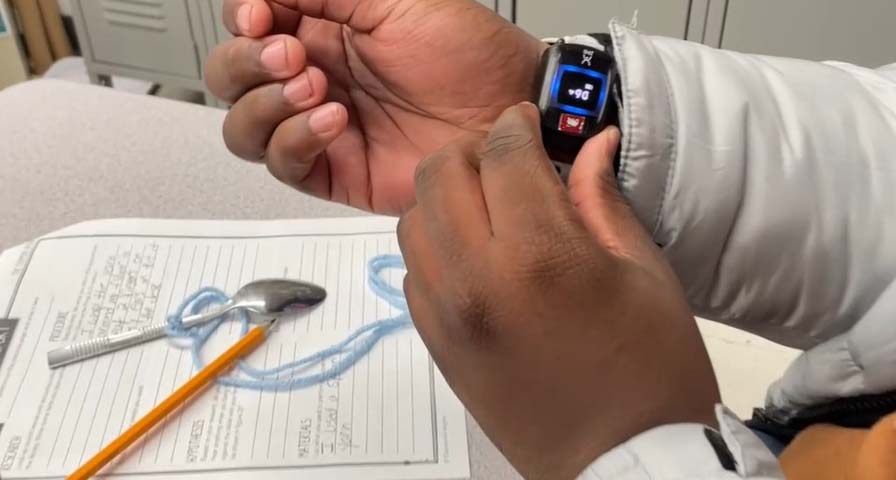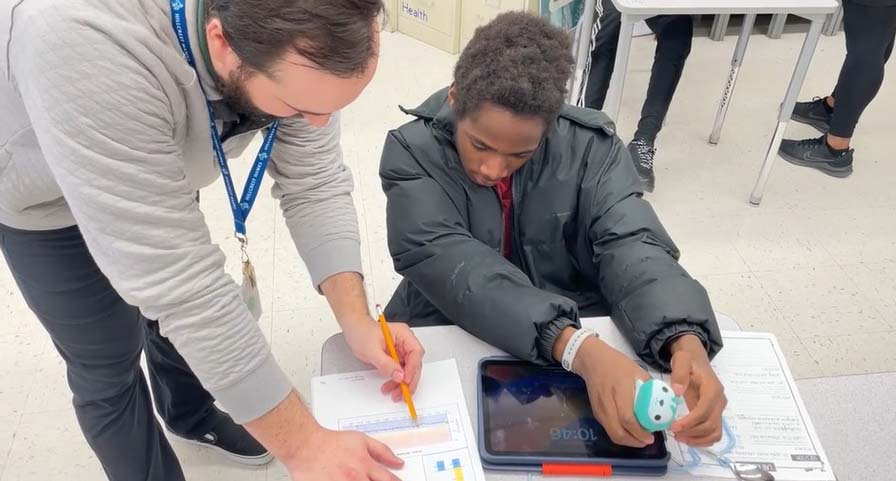Special Education Program Takes Shape After PE Students Use Monitors to Connect Heart Rate to Heightened Emotions
Special education students at Hillcrest High School (Bremen High School District 228, IL) use heart rate monitors to learn when to employ strategies to control their emotions during the school day.
The district has used IHT ZONE heart rate monitors in its physical education program for several years. As students wear the monitors during PE classes, using the real time feedback to improve cardiovascular health by exercising in the moderate and vigorous heart rate zones, PE Supervisor Terri Schrishuhn saw a way for other students – special education students, specifically — to benefit from that same real-time feedback.
“That’s where IHT separates itself (from other heart rate monitors), connecting what the student is feeling whether it’s through physical activity or that emotional physiological response,” Schrishuhn said. “It made me feel like, ‘OK, is there a collaboration here between the physical education and special ed department?’ Not that all students don’t need the emotional awareness, but it was at least one place where we could start.”
Schrishuhn said she noticed that wearing the IHT ZONE monitors enabled PE students to take their understanding of heart rate beyond simply gauging their exercise intensity.
Going Beyond Physical Fitness with Heart Rate Monitors
“We were blown away by how quickly some of our students really caught on and realized how their physical state was impacted when they were feeling certain emotions,” Schrishuhn said. “We were really able to start building a toolbox of coping strategies, and with the support of our staff, when they started to feel those heightened emotions, we could bring them back to a calmer state.”
The toolbox of coping strategies includes, but is not limited to:
- Box breathing
- Journaling
- Listening to music
- Taking a walk
Hillcrest High School Special Education Coordinator Jen Winefka and Special Education Teacher Michael Reid learned about the monitors and introduced a program that is helping students identify when their emotions may be heightened and giving them a way to self-manage.
“Our students within our program struggle with emotional regulation and it’s really hard for them to connect their physical state to their emotional state at the same time,” Winefka said. “The heart rate monitors have been integral in that for us because it provides them with a concrete visual for them to see if they are elevated in a moment and it also provides that for our staff so they can connect that elevated state which has really been super helpful with our students. It’s really been a game-changer for our students in emotional regulation.”
The key, Reid says, is using the daily reports that he prints out. The focal point is a graph of each student’s heart rate throughout the day. Using the graph, students can see when their heart rate spikes and reflect on what triggered the spike.
“In the moment, it’s hard to say ‘hey, my emotions are becoming dysregulated’ or ‘I’m becoming very frantic’ or ‘I’m becoming angry,’” Reid said. “We can go back and look at the data and say ‘remember that feeling you had? Look what happened to your heart rate.’ That connection breeds awareness.”

A student checks his IHT ZONE heart rate monitor to make sure he’s calm while in class.
Students Are Putting Lessons to Practical Use
Crowds make 9th grader Jermaine Brown anxious. Getting through the crowded hallways between classes causes his heart rate to spike. Wearing the IHT ZONE monitor and looking at his heart rate the following day has helped him understand when he’s more anxious and allows him to manage that feeling.
“I can feel my heart starting to beat faster because it’s a lot of people and you’ve got to try and navigate around them,” Brown said. “That’s kind of hard. Over time, my maturity has gotten better, and I’m able to calm down fast enough. I’m trying to breathe in and breathe out. I’m learning to keep my heart rate below 100 (beats per minute).”
Brown and the other students in the program are grasping skills that will serve them into the future, both short-term and long-term.
In the short term, students in the special education program who learn to manage their emotions – and their responses to those emotions – can begin taking general education classes.
“We have students who are earning their way out of our program,” Winefka said. “The heart rate monitors have been a huge piece to that because now they can recognize when they’re feeling a certain way and how that’s impacting them.”
Winfeka pointed to two students: a senior who previously had never had a class outside of the special education program and a freshman. Both are now taking two general education classes.
“The senior has really made a turn for the better and is doing so well,” she said. “The freshman has totally bought into our system. He wears his heart rate monitor all the time….We’re talking about him exiting to a lesser-supported program for the following year. Those are two great stories for us.”
Enabling students to thrive in general education classes is the short term goal, but not the department’s only goal.
“We are preparing them, ultimately, for life after high school,” Winefka said. “They need to be able to do these things at some point individually, and these monitors have been super helpful to getting them along that path.”
For more on Bremen’s use of IHT ZONE heart rate monitors, click here.


